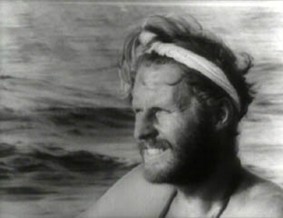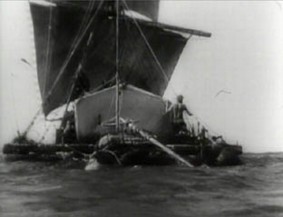|
To
those growing up in the 1950s, I am assured, Norwegian biologist Thor
Heyerdahl was an almost mythic figure. An adventurer
in the true and even heroic sense of the word, he was
prepared to put his money where his mouth was and lay
his life on the line to prove a theory. Allow me to explain. Having observed striking similarities between ancient sculptures found
in the Polynesian South Sea Islands and relics of vanished
civilisations found in South America, Heyerdahl began
looking for a possible connection. Following detailed
research, he came to believe that the islands could
have been settled by ancient civilisations from South
America long before the arrival of Columbus, traveling
on simple craft using the easterly trade winds and sea
currents. He published his theories as a thesis, Polynesia
and America – A Study of Prehistoric Relations, but was soundly scorned by the scientific establishment,
who stated categorically that such a racial migration
at that time was inconceivable. The only boats recorded
to have existed on the coast were primitive, sail-driven
balsa wood rafts, vessels that would, it was believed,
be difficult to control and would collapse as soon as they
hit open water, and would certainly not survive the
4,300 nautical mile journey to the Islands. Heyerdahl thus
decided to put his theories to a practical test by building
his own balsa raft – one based on descriptions recorded by the Spanish on their arrival in the
Americas and employing only materials that would have been
available at the time (no nails or screws were used) – and together with five colleagues attempt to recreate
this theoretical journey.
He named the raft after the ancient Inca
sun god, Kon-Tiki.

Now
you have to get this in perspective to realise the scale
of such an undertaking. This was back in 1947, when Heyerdahl
and his crew had no satellite navigation and only a low power
HAM radio for communication (one powered by a hand-wound
generator), and no fleet of support vessels hovering
a few miles back in case they ran into difficulties. When he and
his crew disappeared over the horizon line, they were
on their own, their position unknown, their fate very
much in their own hands and that of their hand-built craft. Though the expedition attracted international
interest, the expert opinion was that it was doomed to fail,
that the boat would break up before even half of the
journey was complete and that all lives would probably
be lost. One company even promised the whole crew a
lifetime's supply of whisky if they survived. Boy must
their faces have been red. For the crew, the stability
of their craft was only one of the hardships they faced
– shadowed by sharks and whales and battered by storms,
they had to eat what they could catch and drink
diluted sea water and even fluid from the lymph gland
of a fish in order to extend their fresh water supply.
After 101 days at sea the crew finally sighted land,
and in an ironic final twist, became shipwrecked on the rocks
of the uninhabited Polynesian island of Raroia.
Heyerdahl's
literary record of the expidition, titled Kon-Tiki, was translated into sixty-seven languages
and sold in excess of twenty million copies. In 1951 this
film, assembled from footage shot by Heyerdahl and his
crew before and during the journey, was released to
widespread acclaim and won the Academy Award for Best
Documentary. It is this last fact that
will inevitably prompt specific expectations from modern
viewers coming at the film on the back of the recent
spate of technically eye-catching documentary features,
from Bowling for Columbine to Super
Size Me and The Fog of War,
expectations that will likely be disappointed. Kon-Tiki (or at least this version) opens with a written introduction
from Heyerdahl pointing out that the footage was shot
by the crew, all amateurs in the field, but that "what
is shown, however, is what actually took place."
Authenticity is from the outset identified as being
far more important than technical polish – all of the
footage of the expedition was shot hand-held on a wind-up
Bolex camera (the IMDB lists the negative size as 35mm,
but 16mm seems far more likely) with no synchronised
sound – Heyerdahl's narration was recorded in
English for an international audience. The initial introductions
are very formal, the narration delivered in what used
to be called BBC English, and the explanatory map animations
are fairly basic. The footage itself is often rough
and ready and comes across almost as an adventurous
home movie, complete with grainy, unsteady visuals and
jump-cut editing. By modern standards, this
is technically primitive stuff. So why was it such a
success and why did it win the Academy Award?
It's
actually pretty simple: the story. Kon Tiki worked for the 1950s audience and still works today
because the tale it tells is so damned interesting.
If the presentation gives the film the feel of a rather
stiff 1950s BBC special, the
sheer daring of the adventure eventually renders this
irrelevant. Even the voice-over ultimately works for
the film, making even the most extraordinary moments
seem as everyday as they no doubt became to the crew,
lending the film a nice level of understatement. If
the home movie approach means that the epic nature of
the trip is not really conveyed and the lack of sync
sound prevents us really connecting with the characters
on personal level, the film still enthralls in its incident
and detail, from the flying fish that land on deck each
morning to the sometimes alarming
encounters with very large sharks, scenes that will
strike a particular chord with those who were left rattled by Open Water.

There
is the sense that the Academy Award was more a recognition
of Heyerdahl's achievement than his self-confessed amateurism
as a film-maker. In a post-modernist age when the technique
of a documentary is celebrated as much as the content,
the straightforward, even basic presentation of Kon-Tiki may well prove a barrier to some viewers, but it shouldn't.
Whether it really is a great documentary work is a matter
of opinion, but it is certainly an important and ultimately
fascinating record of an extraordinary adventure, and
is presented not as a series of retrospective interviews
and re-enactments, but as a 1947 film equivalent of
a video diary. As Heyerdahl reminds us, what we see
on screen "actually took place," and that's
as good a definition of film documentary as you could ask for.
OK,
this was shot largely hand-held on a wind-up camera
on the high seas, probably on 16mm, and is fifty-four
years old, so it's never going to look pristine, but
even allowing for that the presentation on Image Entertainment's
disk is seriously sub-Criterion. There is a fair amount
of dirt and some scratches, the contrast is variable
(though largely OK) and sharpness is, well, a little
lacking at best and poor at worst. Some of this is clearly
down to the condition of the original print and as such
is perfectly tolerable, but de-interlaced frame grabs
display the sort of ghosting that suggests this NTSC
print has been converted from a PAL video master, adding
to the motion blur and fuzziness. It's certainly still
very watchable, as you automatically make allowances
for the filming conditions, but it could have been a
lot better.
Sound
is Dolby Digital mono 1.0, and is reproduced with very
reasonably clarity, though is lacking in any real bass,
not surprising given the age. As the soundtrack is predominantly
made up of music, narration and ambient sounds, this
is a serviceable transfer, though I suspect that the
music and narration have been re-recorded and the soundtrack
itself remixed for this version (see the following paragraph).
The
running time here is 58 minutes, which would tie in
with the original Norwegian running time (well, sort of, as that
was 55 minutes), but not the version originally released
in the US, which ran for 68 minutes. This version is
identified as a television version produced by the Norwegian
Broadcasting Corporation in 1995, who have replaced
the original opening and closing credits with their
own, and possibly rejigged the soundtrack. This would
again hint at a Scandinavian PAL video source as the
origin for this print.
Not
a thing. There is not even a main menu, just a chapter
selection. Given the wealth of material that could have
been included, this must surely be a prime candidate for
special edition treatment some day in the future.
An
important and involving document of an extraordinary adventure, Kon-Tiki is a film somewhat lost in time,
virtually unknown to a modern audience, who would have
little chance to encounter it by accident, and dated enough in
style for few to actively hunt it out, especially
given this disc's lack of features and less-than-perfect
transfer. If a UK release should ever turn up then I'd
urge those interested in the documentary medium to at
least give it a look, as its low key presentation is actually
a welcome change from the forced emotion and thunderous
dramatics of many more recent documentary works. In the
end it stands as a cinematic testament to the boldness
and determination of Heyerdahl and his crew, and the lengths
this extraordinary group were prepared to go to just to
prove a theory.
|